For the army from the army
The image is simultaneously heart-breaking and heart-warming. A severely-wounded soldier is being helped or literally carried by a brother soldier, just as success is within reach.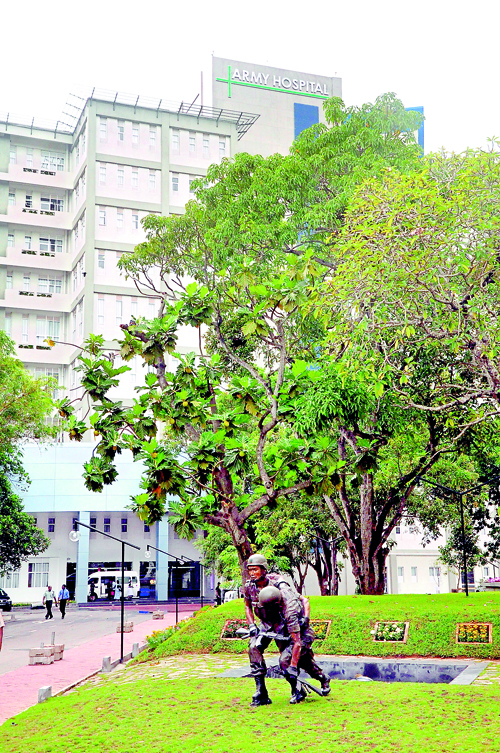
In the euphoria of victory, the fallen and the injured are not forgotten………this is the emotive sculpture that greets all those who enter the premises of the brand-new 1,024-bed Army Hospital at Narahenpita, among the largest in terms of bed-capacity in the country.
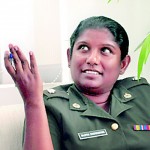
Major Rajitha Nanayakkara
It is President Mahinda Rajapaksa, the Commander-in-Chief of the Armed Forces, who declared open this sleek 10-storey building, amidst a distinguished gathering including Defence Ministry Secretary Gotabaya Rajapaksa.
While on Monday, one patient was “admitted” to the Army Hospital by President Rajapaksa, the others streamed in from Tuesday onwards.
With Army Commander Lt. General Daya Ratnayake stressing that this state-of-the-art Army Hospital has been “vested” in the war heroes by President Rajapaksa in the true sense of “Deshaye Abhimanaya”, the ‘objective’ is to provide the best healthcare facilities to serving army personnel, their family members including their parents, retired

Major Shashikala Perera
personnel and civilians attached to the army to maintain the optimum physical, psychological and social wellbeing in a military oriented, responsive and disciplined approach.
“It is a one-stop centre not only for those who are admitted to the hospital but also for those who seek outpatient treatment,” says Colonel Commandant of the Sri Lanka Army Medical Corps and Director-General of the Army Health Service, Major General (Dr.) Sanjeewa Munasinghe who is also a Consultant Radiologist.
The construction work of the complex has cost Rs. 3.5 billion while the medical, dental and barrack items have amounted to Rs. 1.6 billion.
The Army Hospital is staffed both by army doctors and nurses and some consultants, such as those engaged in plastic surgery, who readily come across from the National Hospital, as well as nurses provided by the Health Ministry. The staff is 1,200 members.
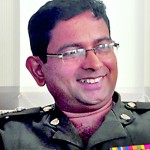
Lt. Col. Kumara
The Sunday Times is taken on a tour of the beautiful building which soothes the senses. Starting from the ground floor Outpatients Department (OPD) where patients would check-in at counters which have as their backdrop shelves packed with files–blue (for officers), green (for soldiers), yellow (for family members), brown (for civilian staff) and red and maroon (for ex-servicemen and officers respectively), we go up to the helipad on the 10th floor with its stunning view of the city and strong gusts of wind that can blow one off one’s feet.
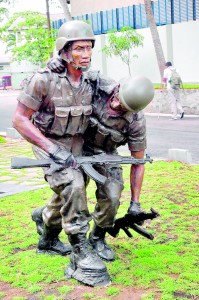
Lest we forget: The emotive sculpture at the premises of the Hospital. Pix by Mangala Weerasekera
This is Phase II of a Master Plan for the Army Hospital complex on 6.1 acres of land. Originally the Army Hospital was located within Army Headquarters at Galle Face from 1950 to 2006, when a bomb explosion and the issues of the hospital being in a High Security Zone, during the height of the war, had to be addressed. By 2006, the orthopaedic wards and the OPD were moved to Narahenpita where the Military Police camp was located. By 2010, the other sections of the Army Hospital still within Army Headquarters had re-located to the former Asha Central Hospital buildings down Horton Place in Colombo 7.
A permanent, spacious hospital complex catering to the 200,000-strong Sri Lanka Army was an urgent need. The Master Plan followed then with the first three-storey building including the OPD, the orthopaedic wards with their own operating theatres (OTs) and intensive care unit (ICU); dialysis unit and also the maternity ward falling under Phase I, being opened on October 10, 2009 — Army Day.
Earlier in February of the same year, Phase II, meanwhile, had begun in earnest with the bare bones or piling being laid, with its proud outcome – the 10-storey building being opened on Monday.
The OPD can see to the needs of 1,000 patients per day, says the hospital’s Commanding Officer, Lt. Colonel (Dr.) Nishantha Pathirana, a Consultant Dermatologist, pointing out that all the facilities are available for these outpatients to get their tests done within the building itself.
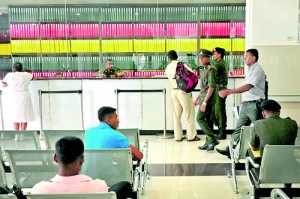
OPD begins to bustle
“Be it an X-ray, a scan, blood test or other tests, the patient can get it done here without stepping outside. They can also take their medicines from the dispensary and head for home by 2 p.m. In other hospitals for tests like scans you have to take another date and come back.”
Referring to the streamlined procedure, Major General Munasinghe says minor ailments would be dealt with in the Medical Inspection Rooms.
The hospital is any Medical Director’s dream come true – 20 wards dedicated to the different disciplines, an ex-servicemen’s ward and in-ward facilities for VIPs such as the Army Commander and VVIPs such as the President.
The list continues….well-equipped ICU, Emergency Treatment Unit, Dialysis Unit, Blood Bank, Dental Institute, investigation laboratories and much more with special facilities including modular OTs and Digital Subtraction Angiography.
The improvement and expansion are not over yet. The next step is the digitization of the files of each and every patient as they tend to become bulky, smiles Major General Munasinghe, adding that all those who report sick from the army camps in and around Colombo are brought by vehicle to the Army Hospital for the ‘Sick Parade’.
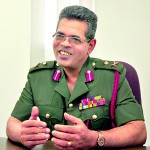
Major General Sanjeewa Munasinghe
When asked why the Army needs such a sophisticated hospital, Major General Munasinghe’s answer is clear — regrettably more than 24,000 soldiers died in the 30-year conflict which also left more than 30,000 disabled in the last phase (2006-2009) alone. “They suffer from a variety of disabilities and we need to pay long term attention to them,” he says citing the example of those with spinal injuries who need to come for check-ups every three months as they can develop bowel and urinary tract issues.
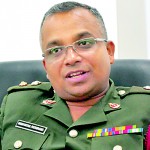
Lt. Col. Nishantha Pathirana
During the war all personnel paid attention to the war and not to their families. Now is the time to take care of the families and give them the maximum health support, he says, adding that ex-servicemen are another group who earlier had no in-ward facilities.
What next? Both Major General Munasinghe and Lt. Col. Pathirana have a clear vision where the Army Hospital should head. Their sights are set on stem-cell transplantation.
Then the Army Hospital will not only be a gift of gratitude from the government to those who defended this country but also a boon to the masses.
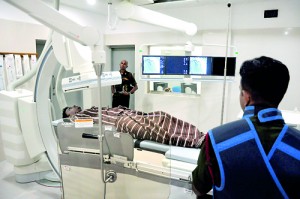
Advanced investigation facilities
| The first patient
Soldier M.M.R. Bandara, 32, from Polpitigama, Kurunegala, is all smiles – it was none other than President Rajapaksa who registered him as the first patient last Monday. 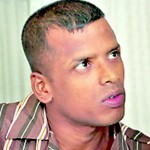 M.M. R. Bandara “My lungs and stomach are sewn up and my right hand does not work,” he says, going back to the time when he was felled by a sniper on August 17, 2008, while he was with an advance party in Thunukkai, in the last phase of the war. Taken to the Anuradhapura Hospital and then brought to the National Hospital in Colombo, it was 45 days there before he could return home. Now working at the Alawwa Ranaviru Apparel, on and off he suffers excruciating pain and a burning sensation in his hand and needs care and treatment. |


